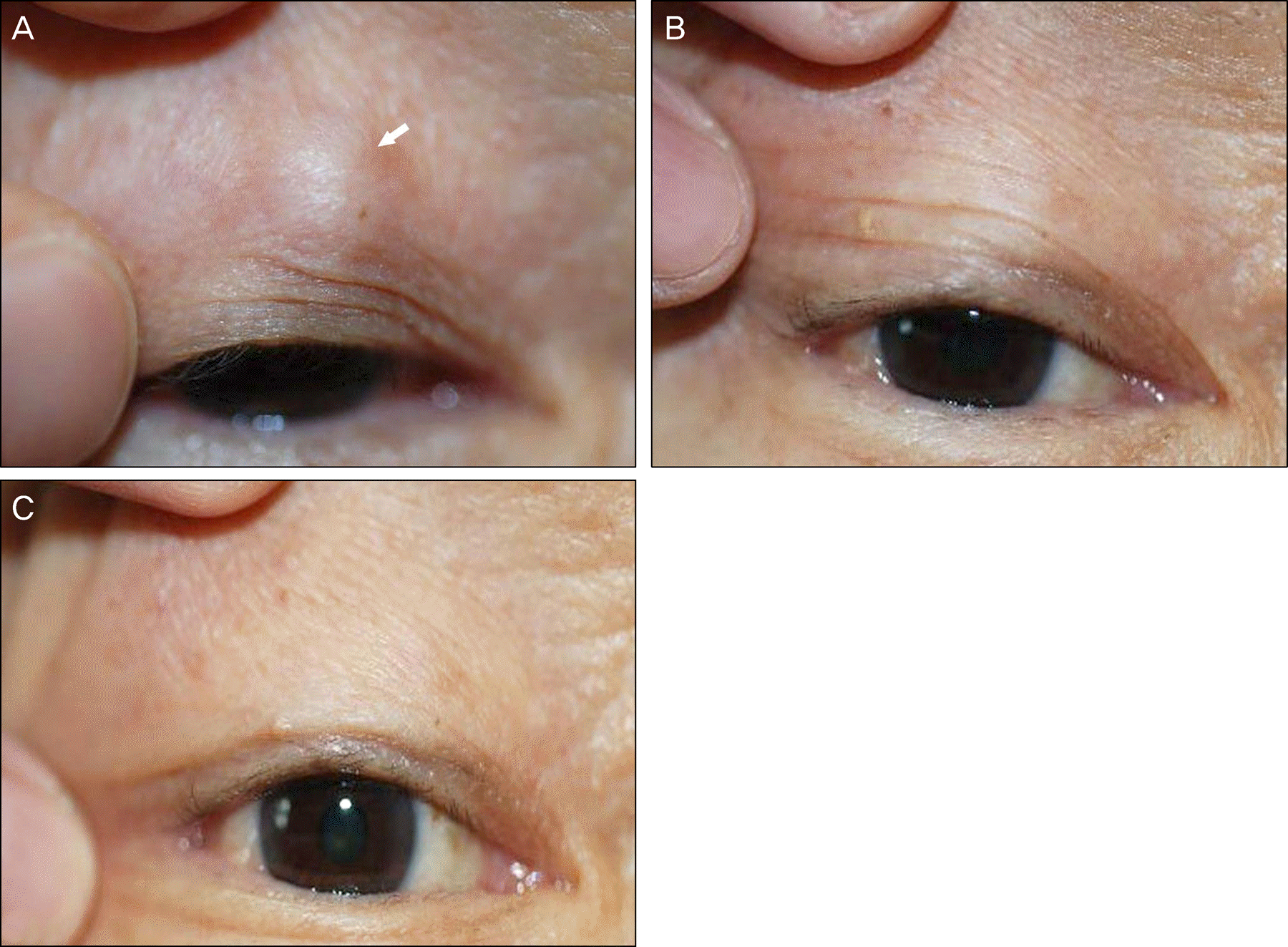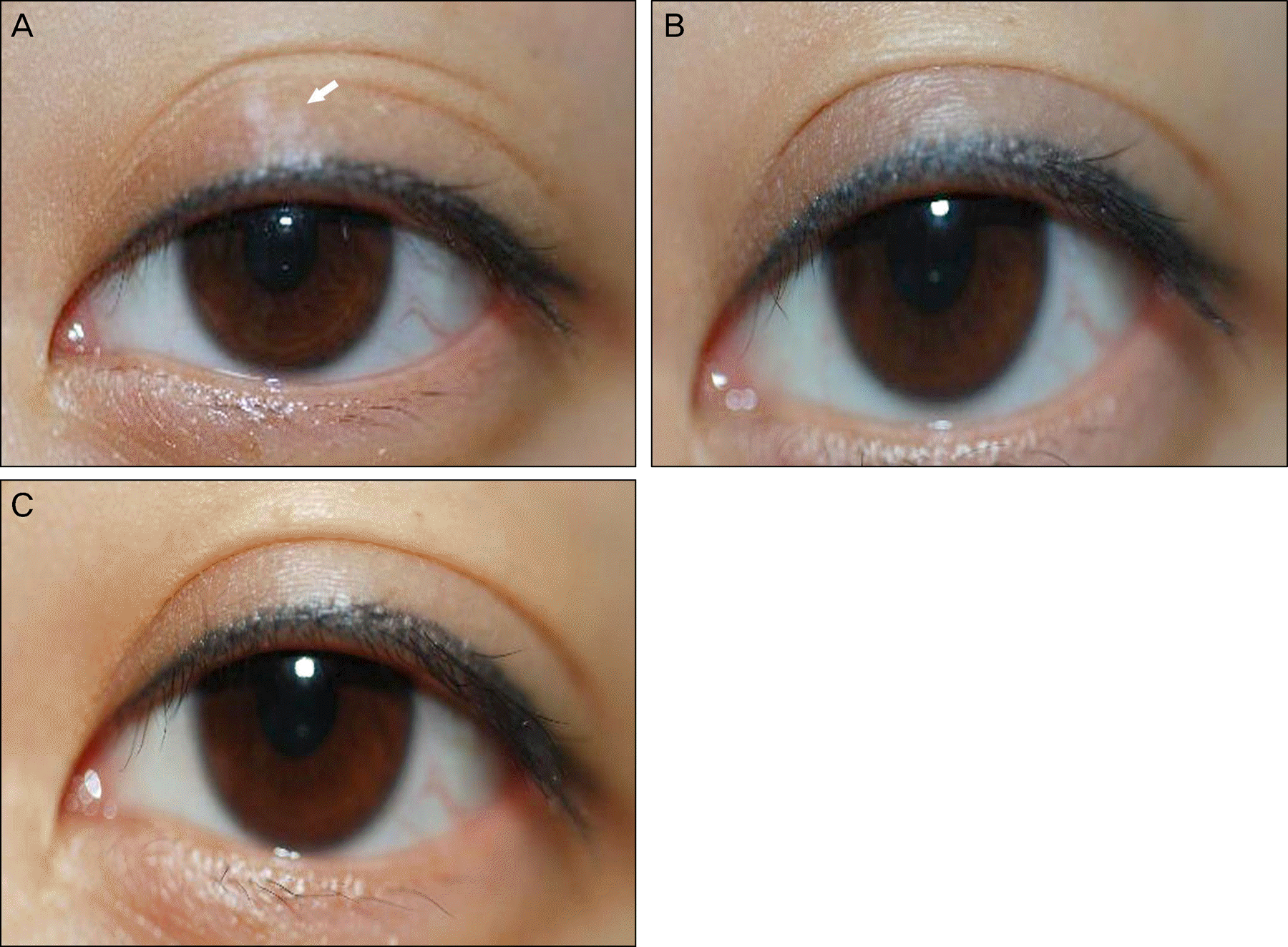Abstract
Purpose
To evaluate the effectiveness of intralesional triamcinolone acetonide injection, and incision and curettage for primary chalazia.
Methods
In order to compare the effectiveness of treatment modality, 103 patients who were diagnosed with primary chalazia were divided into 2 groups. The patients in group A underwent intralesional triamcinolone acetonide injection and the patients in group B underwent incision and curettage. The patients were followed up 1 week and 3 weeks after the procedures to identify the regression of the lesion and the procedure complications. A decision regarding success or failure was made at 3 and 6 weeks after the treatment. Successful treatment was defined as the infallibility in the functional and esthetic aspects as well as the size of regressed lesion.
Results
This study included 82 out of 103 patients, who satisfied the inclusion criteria. Forty-four patients underwent intralesional triamcinolone acetonide injection and the remaining 38 patients underwent incision and curettage. The success rate of the initial treatment, which was identified 3 weeks after the procedure, was 81.8% in group A and 86.8% in group B. The cumulative success rate of treatment after 6 weeks was 86.8% in group A and 92.1% in group B. No complications were observed with both treatment modalities.
Go to : 
References
1. Donaldson MJ, Gole GA. Amblyopia due to inflamed chalazion in a 13-month old infant. Clin Experiment Ophthalmol. 2005; 33:332–3.
2. Ben Simon GJ, Huang L, Nakra T. . Intralesional triamcinolone acetonide injection for primary and recurrent chalazia: is it really effective? Ophthalmology. 2005; 112:913–7.

3. Dhaliwal U, Bhatia A. A rationale for therapeutic decision-making in chalazia. Orbit. 2005; 24:227–30.

4. Dua HS, Nilawar DV. Nonsurgical therapy of chalazion. Am J Ophthalmol. 1982; 94:424–5.
5. Goawalla A, Lee V. A prospective randomized treatment study comparing three treatment options for chalazia: triamcinolone ace- tonide injections, incision and curettage and treatment with hot compresses. Clin Experiment Ophthalmol. 2007; 35:706–12.
7. Prasad S, Gupta AK. Subconjunctival total excision in the treatment of chronic chalazia. Indian J Ophthalmol. 1992; 40:103–5.
8. Watson AP, Austin DJ. Treatment of chalazions with injection of a steroid suspension. Br J Ophthalmol. 1984; 68:833–5.

9. Hirata A, Kubo M, Okinami S. Severe retinal atrophy due to retinal and choroidal vascular occlusion following triamcinolone injection into the nasal mucosa. Jpn J Ophthalmol. 2008; 52:510–1.

10. Hoçal BM, Zilelioglu G. Ocular complication of intralesional corticosteroid injection of a chalazion. Eur J Ophthalmol. 2003; 13(9-10):798–9.
11. Thomas EL, Laborde RP. Retinal and choroidal vascular occlusion following intralesional corticosteroid injection of a chalazion. Ophthalmology. 1986; 93:405–7.

12. Yagci A, Palamar M, Egrilmez S. . Anterior segment ischemia and retinochoroidal vascular occlusion after intralesional steroid injection. Ophthal Plast Reconstr Surg. 2008; 24:55–7.
13. Khurana AK, Ahluwalia BK, Rajan C. Chalazion therapy. Intralesional steroids versus incision and curettage. Acta Ophthalmol (Copenh). 1988; 66:352–4.
14. Mohan K, Dhir SP, Munjal VP, Jain IS. The use of intralesional steroids in the treatment of chalazion. Ann Ophthalmol. 1986; 18:158–60.
15. Pizzarello LD, Jakobiec FA, Hofeldt AJ. . Intralesional corticosteroid therapy of chalazia. Am J Ophthalmol. 1978; 85:818–21.

16. Shorr N, Seiff SR. Central retinal artery occlusion associated with periocular corticosteroid injection for juvenile hemangioma. Ophthalmic Surg. 1986; 17:229–31.

17. Moshfeghi DM, Lowder CY, Roth DB, Kaiser PK. Retinal and choroidal vascular occlusion after posterior sub-tenon triamcinolone injection. Am J Ophthalmol. 2002; 134:132–4.

18. Stapczynski JS. Localized depigmentation after steroid injection of a ganglion cyst on the hand. Ann Emerg Med. 1991; 20:807–9.

19. Papadopoulos PJ, Edison JD. The clinical picture - Soft tissue atrophy after corticosteroid injection. Cleve Clin J Med. 2009; 76:373–4.
Go to : 
 | Figure 1.A Chalazion is seen in the right upper eyelid before the treatment (A) (arrow). One week after the intrale- sional triamcinolone acetonide injection, the lesion showed a definite regression (B). A complete resolution of chalazion is observed 3 weeks after the intralesional triamcinolone acetonide injection (C). |
 | Figure 2.A Chalazion is seen in the left upper eyelid before the treatment (A) (arrow). An evident diminishment in the size of the lesion is seen 1 week after the incision and curettage (B). A complete resolution of chalazion is observed 3 weeks after incision and curettage (C). |
Table 1.
Demographics of 82 patients with primary chalazia treated either by intralesional triamcinolone acetonide injections (44 patients) or incision and curettage (38 patients) at the Eulji medical center between March 2012 and September 2012
| Group A (TA) | Group B (Incision & curettage) | p-value | |
|---|---|---|---|
| No. | 44 | 38 | |
| Age | 31.6 ± 18.1 | 36.9 ± 14.4 | 0.09* |
| Sex | |||
| Male | 20 | 20 | 0.16† |
| Female | 24 | 18 | |
| Duration (weeks) | 5.03 ± 2.90 | 4.14 ± 2.51 | 0.14* |
| Size (mm) | 6.61 ± 1.28 | 6.99 ± 1.72 | 0.51* |
| Location | |||
| RUL | 13 | 10 | 0.81† |
| RLL | 10 | 11 | |
| LUL | 11 | 7 | |
| LLL | 10 | 10 | |




 PDF
PDF ePub
ePub Citation
Citation Print
Print


 XML Download
XML Download